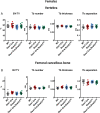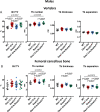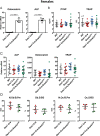Deletion of the scavenger receptor Scarb1 in osteoblast progenitors does not affect bone mass
- PMID: 35349600
- PMCID: PMC8963559
- DOI: 10.1371/journal.pone.0265893
Deletion of the scavenger receptor Scarb1 in osteoblast progenitors does not affect bone mass
Retraction in
-
Retraction: Deletion of the scavenger receptor Scarb1 in osteoblast progenitors does not affect bone mass.PLoS One. 2023 Aug 16;18(8):e0290458. doi: 10.1371/journal.pone.0290458. eCollection 2023. PLoS One. 2023. PMID: 37585400 Free PMC article. No abstract available.
Abstract
The scavenger receptor class B member 1 (SR-B1 or Scarb1) is a cell surface receptor for high density lipoproteins. It also binds oxidized low density lipoproteins and phosphocholine-containing oxidized phospholipids (PC-OxPL), which adversely affect bone homeostasis. Overexpression of a single chain form of the antigen-binding domain of E06 IgM-a natural antibody that recognizes PC-OxPL-increases trabecular and cortical bone mass in female and male mice by stimulating bone formation. We have previously reported that Scarb1 is the most abundant scavenger receptor for PC-OxPL in calvaria-derived osteoblastic cells. Additionally, bone marrow- and calvaria-derived osteoblasts from Scarb1 knockout mice (Scarb1 KO) are protected from the pro-apoptotic and anti-differentiating effects of OxPL. Previous skeletal analysis of Scarb1 KO mice has produced contradictory results, with some studies reporting elevated bone mass but another study reporting low bone mass. To clarify the role of Scarb1 in osteoblasts, we deleted Scarb1 specifically in cells of the osteoblast lineage using Osx1-Cre transgenic mice. We observed no difference in bone mineral density measured by DXA in either female or male Osx1-Cre;Scarb1fl/fl mice compared to wild type (WT), Osx1-Cre, or Scarb1fl/fl littermate controls. Additionally, microCT analysis of 6-month-old females and 7-month-old males did not detect any difference in trabecular or cortical bone mass between genotypes. These results indicate that expression of Scarb1 in cells of the osteoblast lineage does not play an important role in bone homeostasis and, therefore, it is not essential for the effects of PC-OxPL on these cells.
Conflict of interest statement
The authors have declared that no competing interests exist.
Figures








Similar articles
-
RETRACTED: Deletion of the scavenger receptor Scarb1 in myeloid cells does not affect bone mass.Bone. 2023 May;170:116702. doi: 10.1016/j.bone.2023.116702. Epub 2023 Feb 10. Bone. 2023. Retraction in: Bone. 2023 Nov;176:116885. doi: 10.1016/j.bone.2023.116885. PMID: 36773885 Free PMC article. Retracted.
-
Deletion of the scavenger receptor Scarb1 in osteoblast progenitors and myeloid cells does not affect bone mass.bioRxiv [Preprint]. 2025 Jul 12:2025.07.09.663826. doi: 10.1101/2025.07.09.663826. bioRxiv. 2025. PMID: 40672317 Free PMC article. Preprint.
-
A Neutralizing Antibody Targeting Oxidized Phospholipids Promotes Bone Anabolism in Chow-Fed Young Adult Mice.J Bone Miner Res. 2021 Jan;36(1):170-185. doi: 10.1002/jbmr.4173. Epub 2020 Sep 29. J Bone Miner Res. 2021. PMID: 32990984 Free PMC article.
-
The high-density lipoprotein receptor Scarb1 is required for normal bone differentiation in vivo and in vitro.Lab Invest. 2019 Dec;99(12):1850-1860. doi: 10.1038/s41374-019-0311-0. Epub 2019 Aug 29. Lab Invest. 2019. PMID: 31467425 Free PMC article.
-
Gender- and region-specific alterations in bone metabolism in Scarb1-null female mice.J Endocrinol. 2014 Aug;222(2):277-88. doi: 10.1530/JOE-14-0147. Epub 2014 Jun 13. J Endocrinol. 2014. PMID: 24928939
Cited by
-
RETRACTED: Deletion of the scavenger receptor Scarb1 in myeloid cells does not affect bone mass.Bone. 2023 May;170:116702. doi: 10.1016/j.bone.2023.116702. Epub 2023 Feb 10. Bone. 2023. Retraction in: Bone. 2023 Nov;176:116885. doi: 10.1016/j.bone.2023.116885. PMID: 36773885 Free PMC article. Retracted.
-
Retraction: Deletion of the scavenger receptor Scarb1 in osteoblast progenitors does not affect bone mass.PLoS One. 2023 Aug 16;18(8):e0290458. doi: 10.1371/journal.pone.0290458. eCollection 2023. PLoS One. 2023. PMID: 37585400 Free PMC article. No abstract available.
References
-
- Brundert M, Ewert A, Heeren J, Behrendt B, Ramakrishnan R, Greten H, et al.. Scavenger receptor class B type I mediates the selective uptake of high-density lipoprotein-associated cholesteryl ester by the liver in mice. Arterioscler Thromb Vasc Biol. 2005;25(1):143–8. doi: 10.1161/01.ATV.0000149381.16166.c6 - DOI - PubMed
Publication types
MeSH terms
Substances
Grants and funding
LinkOut - more resources
Full Text Sources
Medical
Molecular Biology Databases
Research Materials

